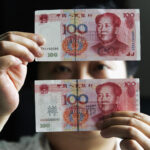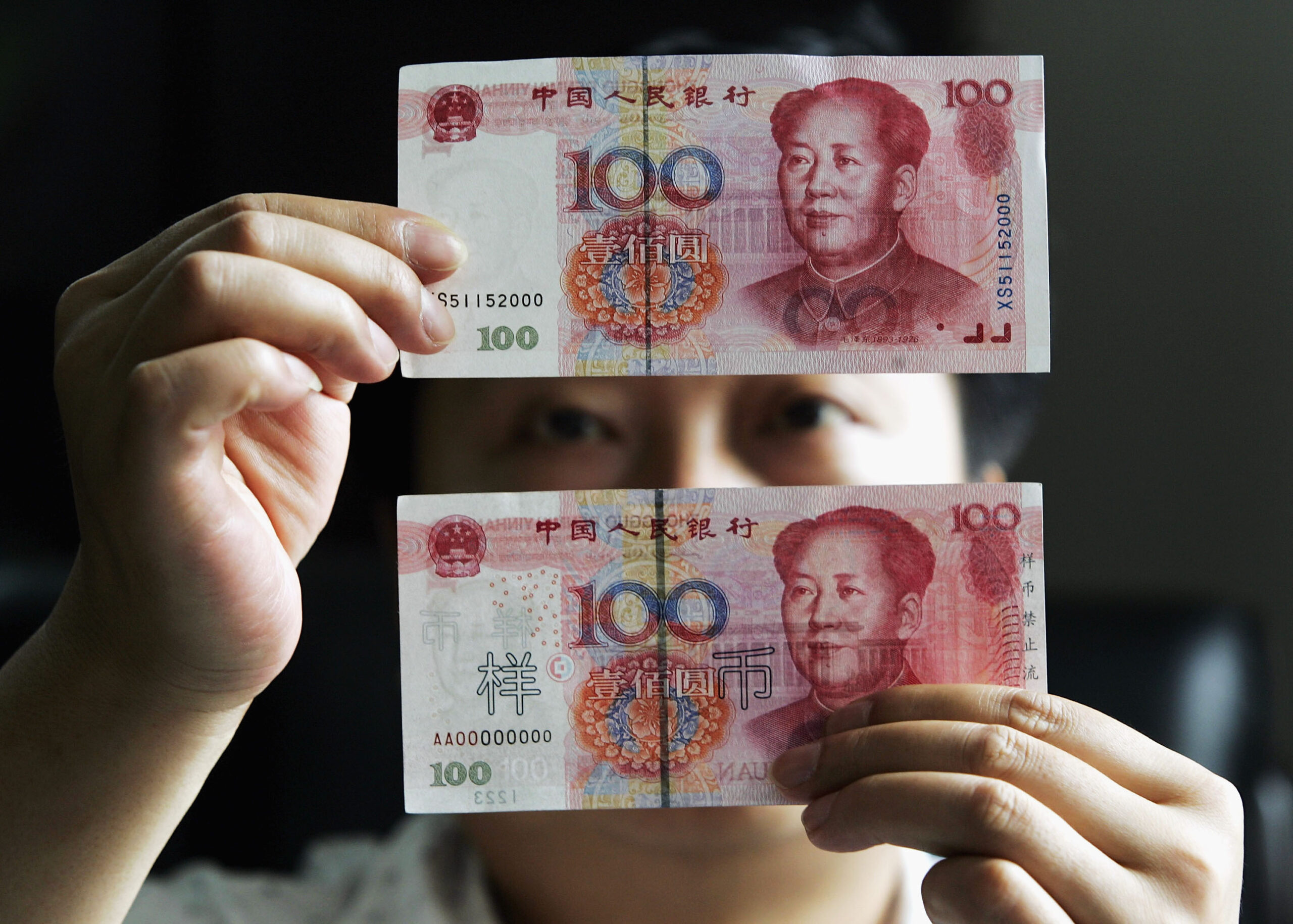Because high dollar rates are a huge problem for China


SHANGHAI, CHINA – AUGUST 31: (CHINA OUT) A Chinese man identifies a new issued 100 yuan note with an old one issued in 1999, at a bank on August 31, 2005 in Shanghai, China. Authorities issued new yuan notes today that largely resemble bills in circulation but with new marks meant to foil currency counterfeiters. New 100, 50, 20, 10 and 5 yuan notes, as well as a 1 jiao coin (10 Chinese cents), were available from the People's Bank of China. The design of the new bills, bearing a portrait of former Chinese leader Mao Zedong, remains the same as the last-issued 1999 series but incorporate new watermarks and other minor changes that will make it harder to duplicate, according to state media. (Photo by China Photos / Getty Images)
According to analysts, the steady flow of capital out of China poses a growing challenge for Beijing and emerging economies, which are already struggling to cope with faltering economic growth and the rapid strengthening of the US dollar, and this problem is being challenged. evidence in an adequately detailed manner by the SCMP.
The US Federal Reserve's third 75bp rate hike on Wednesday brought key interest rates to their highest level since 2008 and further widened the monetary policy gap between the world's two largest economies.
With the possibility of a fourth rate hike in November, the pressure on Beijing looks set to build to avoid an excessive depreciation of the yuan and a massive outflow of capital to the US.
Between February and July, China experienced a record net outflow of $ 81 billion through the Stock Connect and Bond Connect mechanisms, according to data from the Institute of International Finance (IIF). The outflow eased slightly in August, with foreign investors reducing their holdings in Chinese bonds by 30 billion yuan ($ 4.24 billion), according to data from the People's Bank of China (PBOC).
In total, emerging markets recorded their first month of inflows totaling $ 27 billion in August after five consecutive months of outflows, according to the IIF. Net portfolio outflows from emerging markets reached $ 9.8 billion in July.
We are not yet at the levels of 2015, when the PBOC shocked the markets by devaluing the yuan by more than 3%. The IIF estimated that China had a net capital outflow of $ 676 billion in 2015.
However, some analysts are asking Beijing to maintain flexibility in the yuan's exchange rate, even after it recently broke through the key psychological line of 7.0 yuan for the US dollar. And they stress the importance of strengthening economic resilience to offset external shocks.
The yuan, which has recently depreciated against the US dollar, reached 7.0853 per dollar in early Thursday trading on the onshore market – the weakest level since June 29, 2020 – and ended the day at 7.0810 against. the greenback, compared to the previous close of 7.0496.
In a statement on Thursday, Commerzbank analysts warned of the “potential negative impact on the yuan” from the strength of the US dollar and the Fed's political moves. “This is even more pertinent in light of the Fed's latest projection of further hikes this year, ”they added, adding that they expect the PBOC to proceed cautiously with its rate decisions until the cycle of US rate hikes reaches its peak.
The Chinese central bank refrained from lowering its benchmark interest rates in Tuesday's monthly fixing. He also stated that interest rates are "reasonable" and that the country still has room to relax its monetary policy in order to promote economic growth.
The sluggish demand will contribute to the deterioration of trade balances, exacerbating the risk to emerging market currencies stemming from the strengthening dollar, according to a note this week from London-based research firm TS Lombard.
Emerging markets, such as Malaysia, have already begun to suffer from tightening global financial conditions and increased exchange rate volatility, with foreign investors selling their debt and shares. "With the strength of the US dollar and the weakness of the yuan expected to continue, we think the Malaysian Ringgit will still be on the defensive against the US dollar, reaching 4.58 by the end of the year and 4.60 by mid-2023" , UOB Group said in a note earlier this month.
So far this year, the US dollar has strengthened 10.9% against the yuan, 13.7% against the euro, 17.4% against the Korean won and 24.9% against the Japanese yen.
"The main goal of weakening the yuan against the US dollar is perhaps to stabilize the yuan against the basket of trade-weighted currencies," said Zhang Ming, deputy director of the Institute of Finance & Banking at the Chinese Academy of social Sciences.
Despite the weakness against the US dollar, the yuan remains stable against the other currencies of its main trading partners.
"From the perspective of expanding external demand and maintaining a certain level of foreign trade growth, the yuan needs to depreciate moderately at the moment," Wang Yongli, former Bank of China vice president, said last week, adding. that China should take the "necessary" measures to avoid an "excessive" depreciation of the yuan.
In addition to the Fed's aggressive rate hike plans, China's persistent capital outflow, with foreign investors cutting their holdings in Chinese government bonds, is also driven by rising geopolitical tensions, including the invasion of Ukraine by Russia.
The weakening of the yuan leads to gains and losses, but that does not justify excessive concern.
Yu Yongdong, economist
In 2015, to curb the exodus, the PBOC imposed tight capital controls, squeezing interest rates and burning nearly $ 320 billion of foreign exchange reserves to quell market panic and reduce the risk of a flight from the country. yuan.
“All we can do is maintain maximum flexibility of the yuan and continue to manage cross-border capital flows. There are gains and losses in the weakening of the yuan, but that does not justify excessive concern, ”Yu Yongdong, a well-known Chinese economist and former PBOC adviser, said in a blog post on Tuesday. Capital flight to China could be relatively serious, but its gravity is difficult to assess ”.
“To radically solve the problem of capital flight, China must deepen its institutional reforms. But… the management of cross-border capital cannot be abandoned ”.
"Fed rate hikes have put pressure on China's macroeconomic policies, but fundamentally the challenges come from within."
The value of China's foreign exchange reserves has gradually shrunk but remains steadily above $ 3 trillion, the largest total in the world. Reserves stood at $ 3.05 trillion at the end of August, according to China's foreign exchange regulator, the State Administration of Foreign Exchange (SAFE).
Surprisingly, China cuts its benchmark interest rate by 10 basis points
August 15, 2022
In April, a 10-year lead on Chinese government bond yields over US yields vanished. Yields on US government bonds are now higher than Chinese ones, making US bonds more attractive to investors. According to some, the PBOC may take note.
Jin Yi, head of the fixed income team at Sealand Securities, said the average interest rate differential between Chinese and US government bonds was around 14 basis points in the second quarter of 2022, which corresponds to a $ 19 billion decrease in China's foreign exchange reserve assets over the same period, according to data from SAFE. However, dollar deposits held by exporters and companies in China's onshore banking system amount to around $ 1 trillion, and this could limit the US dollar's rise against the yuan, according to a note from Western Asset last week.
In the meantime, however, at present, the super-dollar is strengthening against almost any currency, including the Yuan, and this continues to be an incredible attraction for capital, Chinese in the lead.

Thanks to our Telegram channel you can stay updated on the publication of new articles of Economic Scenarios.
The article Why high dollar rates are a huge problem for China comes from ScenariEconomici.it .
This is a machine translation of a post published on Scenari Economici at the URL https://scenarieconomici.it/perche-gli-alti-tassi-sul-dollaro-costituiscono-un-enorme-problema-per-la-cina/ on Fri, 23 Sep 2022 06:00:01 +0000.
